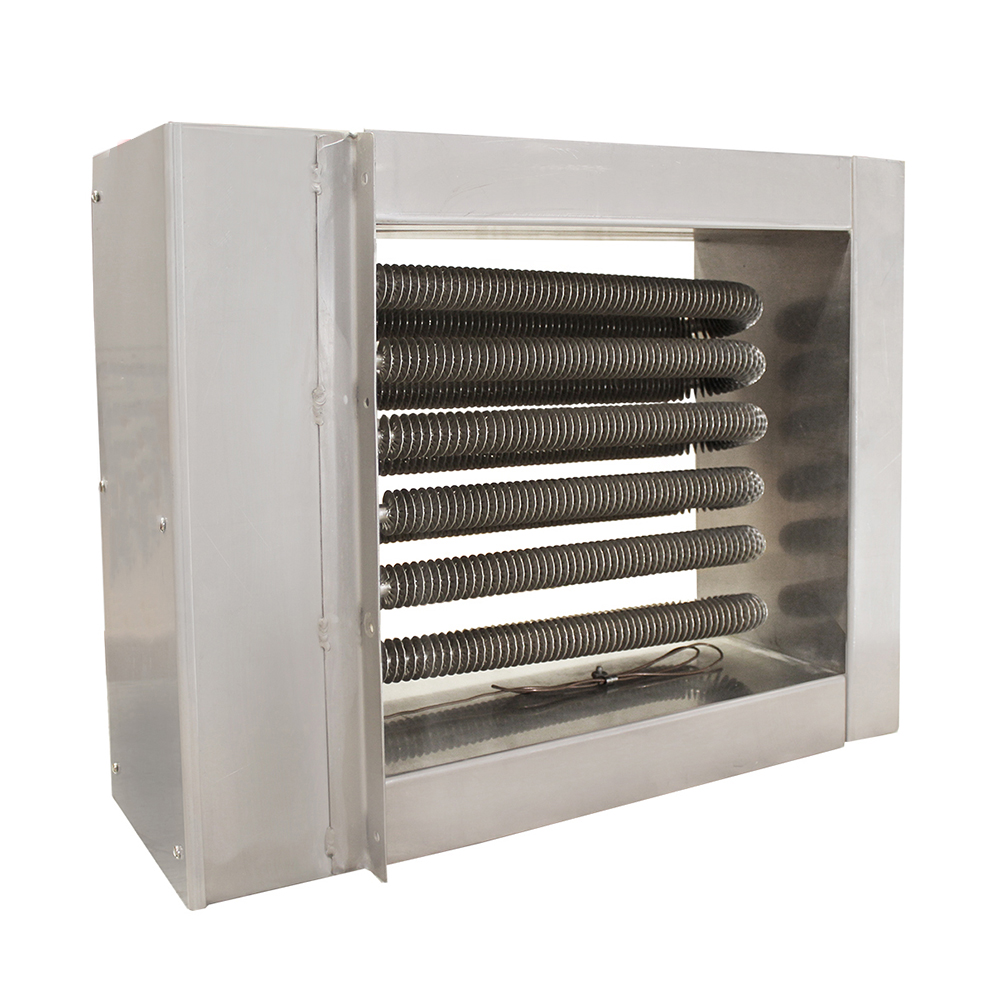1. What is an Air Duct Heater?
An Air Duct Heater is an electric heating device installed inside ventilation ducts to heat the air flowing through HVAC (Heating, Ventilation, and Air Conditioning) systems. It plays a crucial role in maintaining desired indoor temperatures and ensuring thermal comfort or process-specific heating requirements in various environments.
These heaters typically consist of heating elements (such as finned resistance wires), a metal housing , temperature control systems , and safety protection devices like overheat sensors and circuit breakers. They are designed to operate efficiently within ductwork without significantly impeding airflow.
2. Working Principle of Air Duct Heaters
The working principle of an air duct heater is based on resistive electrical heating combined with forced convection heat transfer .
a. Electrical Resistance Heating
Inside the heater, electric resistance coils or elements generate heat when current passes through them. These elements are often made from materials such as nickel-chromium alloys , known for their high resistivity and durability at elevated temperatures.
b. Heat Transfer via Airflow
As air moves through the duct system, it passes over the heated elements. The heat is then transferred to the air via convection , raising its temperature before being distributed throughout the building or industrial space.
c. Temperature Control and Safety Features
Modern air duct heaters are equipped with thermostats and limit switches that regulate the output temperature and prevent overheating. Some models also include fan interlocks , which ensure the heater only operates when the blower fan is running, preventing dangerous heat buildup.
3. Types of Air Duct Heaters
There are several types of air duct heaters, each suited to specific applications:
Inline Duct Heaters : Installed directly within the duct, these are ideal for central HVAC systems.
Flanged Duct Heaters : Bolted into a cut-out section of the duct, commonly used in industrial settings.
Open Coil Duct Heaters : Feature exposed heating coils for rapid heat transfer; often used where space is limited.
Closed Tubular Duct Heaters : Enclosed heating elements offer better protection and are suitable for clean environments.
4. Key Advantages of Air Duct Heaters
Energy Efficiency : Operate only when needed, reducing energy waste.
Precise Temperature Control : Integrated thermostats allow accurate regulation of air temperature.
Compact Design : Easily integrated into existing duct systems without major modifications.
Low Maintenance : Few moving parts result in minimal wear and long service life.
Versatility : Suitable for both residential and industrial applications.
5. Common Application Scenarios
Air duct heaters are widely used across multiple sectors due to their efficiency and adaptability.
a. Residential and Commercial HVAC Systems
In homes, offices, and commercial buildings, duct heaters supplement central heating systems, especially in areas with extreme cold. They help maintain consistent indoor temperatures during winter months.
b. Industrial Process Heating
Industries such as plastics, food processing, and chemical manufacturing use duct heaters to preheat air for drying, curing, or reaction processes. They are essential in maintaining optimal conditions for production lines.
c. Cleanroom and Laboratory Environments
In controlled environments like laboratories and cleanrooms, duct heaters help maintain precise temperature levels required for sensitive equipment and experiments.
d. Ventilation Systems in Cold Storage Facilities
Cold storage facilities may use duct heaters to prevent condensation and frost formation in ventilation systems by slightly warming the incoming air.
e. Agriculture and Greenhouses
Duct heaters are used to regulate temperatures in greenhouses and livestock barns, ensuring a stable climate for plant growth and animal health.
6. Installation and Safety Considerations
Proper installation is critical to the safe and efficient operation of air duct heaters. Key considerations include:
Ensuring adequate clearance around the heater to avoid fire hazards.
Properly matching the heater’s power rating with the airflow rate to prevent overheating.
Installing safety controls such as thermal fuses , overheat sensors , and fan interlock relays .
Regular inspection and cleaning to prevent dust buildup, which can cause overheating or reduce efficiency.
Air duct heaters are essential components in modern heating systems, offering efficient, reliable, and flexible solutions for a wide range of applications. Whether used in residential HVAC systems or industrial process heating, they provide precise temperature control and contribute to improved comfort and productivity. With proper installation and maintenance, air duct heaters can deliver years of dependable performance while ensuring safety and energy efficiency.


 English
English русский
русский Français
Français Español
Español عربى
عربى
